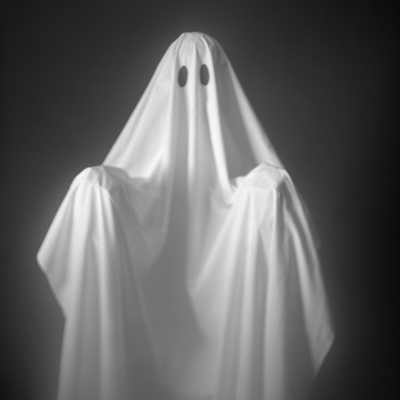Having recently taken courses in quantum field theory and particle physics, I've been noticing more correspondences between quantum fields and metaphysics (some of which was discussed in my previous entry here), but I'd like to bring up one more neat topic:
Ghosts and Virtual Particles
 Believe it or not, there are ghosts in physics. Well, "ghost particles" and "ghost fields", to be precise. When I first heard about them, I was swift to imagine all sorts of ghost fields about the world, ghosts interacting with particles...So what are "ghosts" in physics?
Believe it or not, there are ghosts in physics. Well, "ghost particles" and "ghost fields", to be precise. When I first heard about them, I was swift to imagine all sorts of ghost fields about the world, ghosts interacting with particles...So what are "ghosts" in physics?
In quantum field theory, particles correspond to fields that can be described as waves. Ghosts are additional fields added to a theory so that the math is consistent. They're a kind of "virtual particle", particles that cannot be observed but are considered to be present in certain particle interactions to make things consistent.
For example, say you have two electrons interacting (see diagram below). Well, one of them will be an electron (e⁻) and the other one will be a positron (e+...this is the antiparticle of the electron. It's just the same as the electron except it has a positive charge. Antiparticles have arrows pointing against the flow of time. Just to confuse you). Time flows from left to right, so the two particles come in and annihilate to form a photon (ɣ), which then does some fancy things before becoming an electron and positron again.
However, we can only observe the initial and final states of particle interactions: the two particles coming in, and the resulting particles coming out (which happen to be the same as the initial particles in this case). But what happens in between?

i.e., you can't make a cat appear in the loop. So barring strangely appearing Pusheens, the example above shows that a photon is created, it turns into a certain particle and antiparticle (the loop), which then recombine to form a photon. This last photon turns back into an electron and positron. In principle, you could have more loops too (these are known as "higher order" diagrams).
Both the photons and the loop particles are virtual particles. They aren't particles you can observe because it isn't possible to observe anything more than the particles going in and the particles going out of the experiment. In particular, ghost particles appear as loops in diagrams, so the loop in the above diagram could be due to ghost particles.
Ghosts are basically nonphysical particles that appear and disappear in the math depending on a choice of what is known as gauge. You have to choose a gauge when you want to calculate most things in quantum field theory, and although the choice of gauge doesn't change the physical particles you observe, it will determine whether or not there are ghosts. One of the reasons they're called ghosts is because they violate what is known as the spin-statistics theorem: ghosts are spin 0 particles, but they behave as if they were particles with a half-integer spin (1/2, 3/2, etc). This isn't allowed to exist in nature: just like you can't have two positive charges attract each other, you can't have ghost particles really existing.
So what form of existence do these ghosts/virtual particles have, if you, a mere human being, can introduce them in the math depending on whether or not it's convenient for your calculations? Do they correspond to anything in nature, even though they can't exist as real particles? Do virtual particles exist in a sort of "playground" of nature, something like a higher level experiment that we only see the end results of?
Physics, by using mathematics, is trying to piece together some of these questions (though usually without a philosophical bent, mind you). It's trying to understand not only what we can observe, but the underpinnings of the world: how it actually works, and how it came to be the way it is. Perhaps these virtual particles are like Plato's forms, a higher level of "ideas" above the physical world. They're potentially real particles, but only come into existence if they adhere to whatever physical laws are set up in a particular universe. Change those laws, and another set of particles might come into being. So what could be ghost particles in our universe could be completely viable particles in another universe with another set of laws, and vice versa: their ghost particles might be things like electrons, positrons, and photons--things that are totally viable here. Some particles, like photons, can have a real existence our world--they can be observable particles of an experiment. Ghosts, on the other hand, cannot be: they can only exist in loops, so it's like they can exist in the realm of potentiality, but not actuality: they can't be observed in the physical world by us.
 These are just my ideas on this, and I'm far from sorting it out, but it's important to think about. This is definitely important in determining how certain ideas/forms become substantiated in the world around us. Why can some things become "real" and not others? What set of laws could let ghost particles exist? I think this could help us get a better grasp of what reality is, and how it's related to things that could potentially exist but do not.
These are just my ideas on this, and I'm far from sorting it out, but it's important to think about. This is definitely important in determining how certain ideas/forms become substantiated in the world around us. Why can some things become "real" and not others? What set of laws could let ghost particles exist? I think this could help us get a better grasp of what reality is, and how it's related to things that could potentially exist but do not.I almost want to make this comparison: a unicorn is to the animal kingdom what ghost particles are to particle physics. Just something to think about.
 And, believe it or not, there are also "good ghosts" and "bad ghosts" in quantum field theory (but that's a bit more mathematically involved to explain). Not to mention "anti-ghosts" :)
And, believe it or not, there are also "good ghosts" and "bad ghosts" in quantum field theory (but that's a bit more mathematically involved to explain). Not to mention "anti-ghosts" :)Tweet





















1 comments:
Very cool discussion! Thanks!
Post a Comment